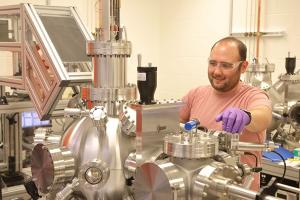
New electric cars in all shapes and sizes are coming to a dealer near you. Automakers plan to introduce almost 100 pure electric models by the end of 2024, according to recent coverage by Consumer Reports magazine. Eleven auto manufacturers including Ford and GM have pledged to work toward all sales of new cars and vans being zero emissions by 2040.
To fulfill this ambition, automakers must overcome their battery problem. The electric vehicle’s standard lithium ion battery takes too long to charge while on the road. It also contains a flammable liquid, posing a hazard for drivers, passengers and emergency responders if the battery is damaged during an accident.
Ian Brummel, a Ph.D. student at the University of Virginia School of Engineering and Applied Science, is studying materials that will make the lithium battery safer and allow it to charge faster. Brummel is a member of the Multifunctional Thin Film Research Group led by Jon Ihlefeld, associate professor of materials science and engineering and electrical and computer engineering.
The conventional lithium ion battery relies on a liquid electrolyte to conduct a charge. The liquid electrolyte is contained in a porous, polymer membrane that separates the battery’s negative side, or anode, and positive side, the cathode. Ions travel within the liquid through the membrane to discharge the battery and allow electric current to flow to the motor. When the car is plugged in, the system cycles the ions back to their starting place.
Ihlefeld and Brummel propose replacing the flammable liquid with ion-conducting ceramics. Whereas industry has begun to invest in the development of ceramic batteries, they approach the challenge through fundamental research into ceramics’ structure and properties at the atomic level. Brummel is studying how the orientations between two crystals affect conduction. A grant from the National Science Foundation’s Division of Chemical, Bioengineering, Environmental and Transport Systems supports Brummel’s research.
“This is the type of opportunity I’ve been searching for since high school,” Brummel said. “I’ve always been on board with green energy and believed that a great battery would be our next advancement.”
Brummel and Ihlefeld connected at the Sandia National Laboratories. Ihlefeld joined Sandia in 2008; his principal research interests involved functional materials, including those for infrared filters and novel computer memories, as well as thin films to improve lithium ion, low-profile batteries. Brummel participated in a cooperative research program at Sandia while completing his Bachelor of Science degree in materials science and engineering at the Colorado School of Mines.
“Jon’s research was exactly what I wanted to do,” Brummel said. “I wanted my research to have the potential to help the human race.”
A coincidence of timing and opportunity led Ihlefeld to UVA Engineering in August 2017, just as Brummel was networking for graduate schools. Brummel began his Ph.D. studies as a member of Ihlefeld’s group in June 2018.
Brummel’s strong background in materials characterization promises to accelerate new and experimental techniques in lithium battery research. “Ian has been working on the battery problem from my start-up funding,” Ihlefeld said. “With the infusion of the NSF grant, he can really dive in.”
Brummel’s study of ceramics’ structure is targeted toward applications in transportation, one of the biggest bottlenecks in transforming the global economy. But Brummel and Ihlefeld agree that the applications of a solid-state battery have broader potential.
“Anything we can do to make a battery better and safer is a big deal,” Ihlefeld said. “A breakthrough battery could go anywhere from handheld devices to grid storage.”